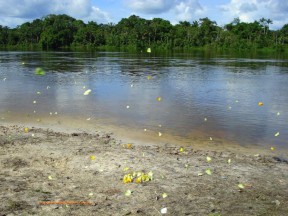Laemolyta taeniata
Striped Headstander
SynonymsTop ↑
Schizodon taeniatus Kner, 1858
Etymology
taeniata: from the Latin taeniatus, meaning ‘beribboned’.
Classification
Order: Characiformes Family: Anostomidae
Distribution
Native to the central portion of the Amazon basin but the full extent of its range is somewhat unclear.
Type locality is ‘Rio Guaporé, Manaus, Mato Grosso, Brazil’ and this species is known from the rios Madeira (of which the Guaporé is a tributary) and Negro in Brazil including a number of tributary drainages and floodplain lakes.
It’s also been recorded in the Bolivian portion of the Guaporé, where the river is known as the Iténez, the Río Orinoco system in Venezuela and rios Ampiyacu and Nanay in Loreto Region, Peru.
More recently Matauri and Menezes (2006) reported it to occur in the rio Tocantins system so it may be more widely-distributed than is typically accepted.
Habitat
Something of a habitat generalist and has been collected from smaller tributaries, main river channels, oxbows and floodplain lakes, and typically migrates into flooded forest areas during the wet season.
It’s been observed to form large migratory shoals withother species such as Leporinus fasciatus and L. agassizii.
Other species occuring in the Río Negro and available in the trade include Acestrorhynchus falcatus, A. falcirostris, Pseudanos gracilis, Chalceus macrolepidotus, Hemigrammus bleheri, H. schmardae, H. stictus, Hyphessobrycon pyrrhonotus, H. socolofi, Paracheirodon axelrodi, P. simulans, Carnegiella marthae, Copella meinkeni, Nannostomus trifasciatus, Acarichthys heckelii, Apistogramma gibbiceps, Biotodoma wavrini, Biotoecus opercularis, Cichla orinocensis, Crenicichla notophthalmus, Dicrossus filamentosus, Geophagus dicrozoster, Heros notatus, Hoplarchus psittacus, Pterophyllum altum, Satanoperca daemon, S. lilith, Corydoras adolfoi, C. duplicareus, C. imitator, C. nijsseni, C. robineae, Ancistrus dolichopterus, Dekeyseria pulchra, Peckoltia braueri and Potamotrygon schroederi.
Maximum Standard Length
The largest officially-recorded specimen measured 288 mm.
Aquarium SizeTop ↑
An aquarium with base dimensions of 120 ∗ 60 cm or equivalent should be the smallest considered.
Maintenance
Décor is relatively unimportant and maintenance simple provided water flow is not too strong and lighting not bright.
A natural-style arrangement could consist of a sandy substrate with some leaf litter plus large driftwood branches and twisted roots and perhaps some floating vegetation.
Water quality is of the utmost importance and this species should never be introduced to a biologically immature aquarium.
A well-fitting cover is also essential as anostomids are prodigious jumpers.
Water Conditions
Temperature: 20 – 28 °C
pH: 4.0 – 7.5
Hardness: 18 – 215 ppm
Diet
This species is an omnivorous grazer browsing solid surfaces for algae, insect larvae and other small items in nature.
In the aquarium it should be offered small live and frozen foods as well as plenty of vegetable matter in the form of blanched spinach, lettuce, cucumber, courgette, algae wafers, etc.
Behaviour and CompatibilityTop ↑
Relatively peaceful towards conspecifics and best maintained in a group comprising four or more specimens in a large community of peaceful, comparably-sized fishes.
Possibilities include various characids, loricariids, doradids and cichlids, but be sure to research your choices thoroughly prior to purchase.
Sexual Dimorphism
Unconfirmed but presumably mature females grow slightly larger and are rounder-bellied than males.
Reproduction
Unrecorded.
NotesTop ↑
L. taeniata is the largest-growing and second most widely-distributed member of the genus although it’s a rarely-seen in the aquarium trade.
It can be distinguished from all congeners since it uniquely possesses 5 lateral scale rows between the lateral line and dorsal-fin origin (vs. 4 or 6–8 in the remaining species).
Its colour pattern is comparable to that of L. garmani and L. orinocensis, but it can be distinguished from L. garmani by possessing a dark midlateral stripe and more conspicuous narrow light stripes above the lateral line, and from L. orinocensis in possessing fewer lateral line scales (42–46 vs. 47–52).
Laemolyta can be told apart from all other genera contained within Anostomidae by the symphyseal tooth of the dentary being of approximately equal size to the second tooth.
Both of these teeth are spatulated, highly compressed, and with a straight upper edge (vs. symphyseal tooth sometimes much larger than the second tooth or slightly larger than the second tooth and sometimes cusped in the same way as the remaining dentary teeth, thick or recurved in related genera).
In addition, adults possess plus a protuberance on the anteroventral region of the ectopterygoid, in the elongated mesopterygoid, with a small ventrally-directed process on the lateral surface and the ventral margin poorly developed, plus a supra-terminal mouth which is a feature shared only with the genus Anostomoides among other anostomids.
The family Anostomidae has been recognized as a monophyletic assemblage since Vari (1983) based primarily on synapomorphies relating to modifications of the gills and suspensorium.
References
- Mautari, K. C. and N. A. Menezes, 2006 - Neotropical Ichthyology 4(1): 27-44
Revision of the South American freshwater fish genus Laemolyta Cope, 1872 (Ostariophysi: Characiformes: Anostomidae). - Reis, R. E., S. O. Kullander and C. J. Ferraris, Jr. (eds.), 2003 - EDIPUCRS, Porto Alegre: i-xi + 1-729
Check list of the freshwater fishes of South and Central America. CLOFFSCA.






